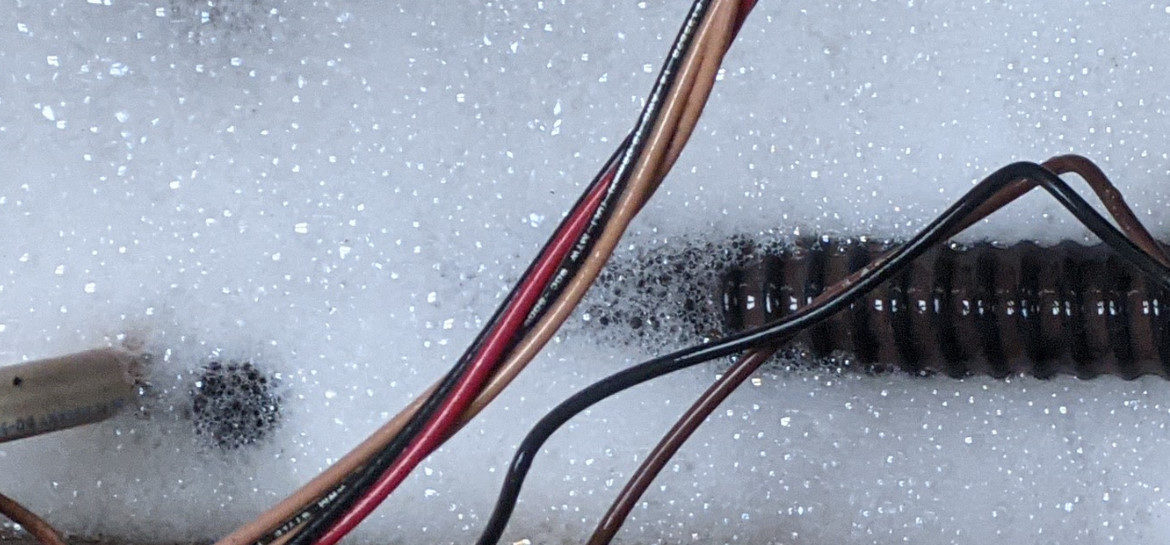
Every now and then, a bilge needs a bubble bath.
The bilge is the lowest part of the interior of a sailboat, typically below the floorboards in the cabin, where water would collect if it were to enter the boat. Historically, it may have had a slightly different meaning, related to the exterior part of a ship where it would rest if it were gently placed on the ground, and it may be related to the curved part of a barrel (i.e., the “bulge”). If you were to learn about bilges only from sailing forums, you would think that they are an arid, pristine place where no droplet of water had ever been and where you could safely store your loose macarons. In my experience, they’re not exactly that. Sailboats with inboard engines have a live prop shaft that has to go through the hull, and while there’s a seal around that, it’s not exactly perfect and drips a small amount of water, especially when running. The crib boards have holes in them for ventilation, and don’t really seal that well in hard rains. The interiors of boats can also produce condensation that usually winds up in the bilge, along with any errant fuzz, debris, and, for some reason, a shocking amount of hair.
There’s also a pump down there to pump out any water that should show up, called the bilge pump. I mentioned in the previous log entry that my bilge pump was having problems. When I arrived at the boat a week ago, it was running continuously despite having the minimum amount of water in it. There’s a float switch that is supposed to turn the pump on if the water should get over a certain level, and then turn it off again when it gets down the unpumpable dregs. Mine apparently wasn’t turning off. I cycled the power and it stopped, but then it did it again the next night. The bilge pump is also what would keep your boat from sinking if it somehow acquired a leak (at least a relatively minor one), so it’s unnerving when it’s not working correctly. This weekend, I went down on a solo run to fix it.
My first guess was that the float switch was just dirty. There is literally a small floating object in it, and it needs to be able to move up and down with the water level to indicate to the rest of the switch whether it should turn the bilge pump on or off. I had kind of cleaned it last weekend, but I thought maybe it (and the rest of the bilge) could use a more thorough cleaning. Despite my admission that my bilge is neither dry nor terribly clean, there are still limits to what I’ll cop to, so in the interest of modesty, I will only show it in bubble bath form.
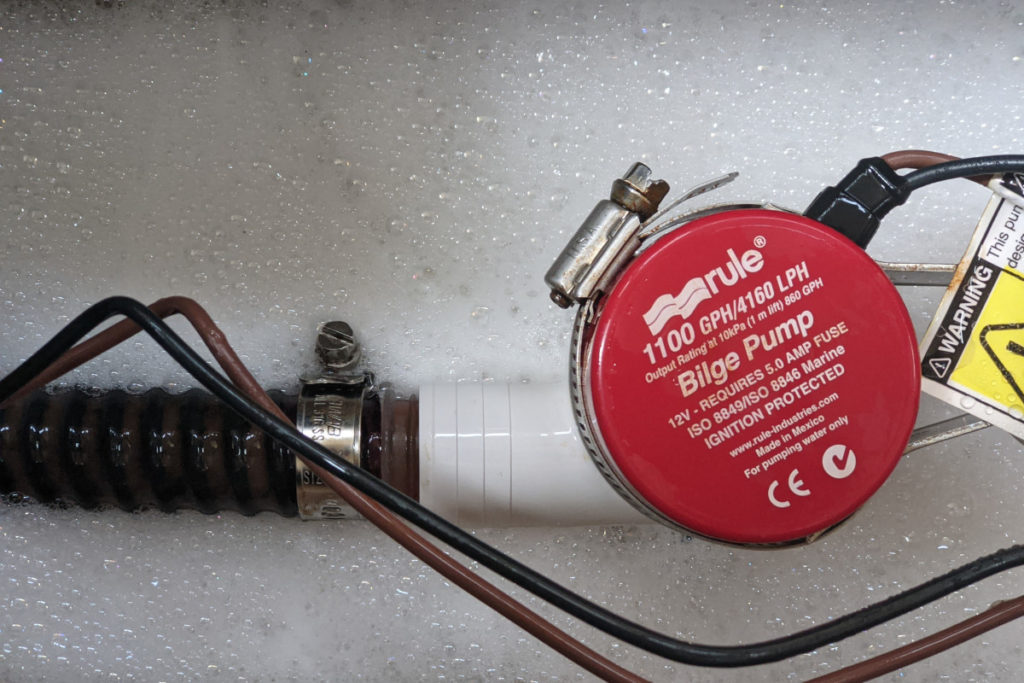
I have some eco-friendly, biodegradable soap that I use for this purpose, since the bilge pump simply shoots the water out of the aft end of the boat into the creek. I wanted to get the bilge good and tidy before disassembling anything to limit the chances that something else would foul the pump or switch after I cleaned them, so I gave it a good scrubbing and several rinses. I also have the world’s smallest wet/dry “shop vacuum” on board that did a good job of sucking up some of the suspended crud in the bilge water, but it only has a one gallon capacity, which it can fill in approximately four seconds. I briefly considered suspending the motorized portion of the shop vacuum over a much larger bucket, but I visually traced the power cord back to the 110V outlet and concluded that I didn’t want my obituary to end with “He died doing what he loved: sucking wet filth out of a dirty bilge.”
Once the bilge itself was clean, I took out the pump and float switch. When I had done the cursory rinse last weekend, it was the middle of the night with only the cabin lights to illuminate things. and I didn’t really think to inspect it any sort of useful way. I installed this switch in 2015, and I remembered it being completely sealed and potentially impossible to clean, to the point where this week, I bought a replacement switch. But I remembered it wrong—seeing it in daylight, it was clear that it could be disassembled, presumably exactly for this purpose. I think that the designers also accounted for it getting pretty dirty. The tolerances of the moving parts are quite generous, and even in its junked-up state the float moved freely. I could turn the pump on or off at will by flipping the switch over…except when it stuck “on” for no apparent reason. Which was why I was messing with it in the first place.
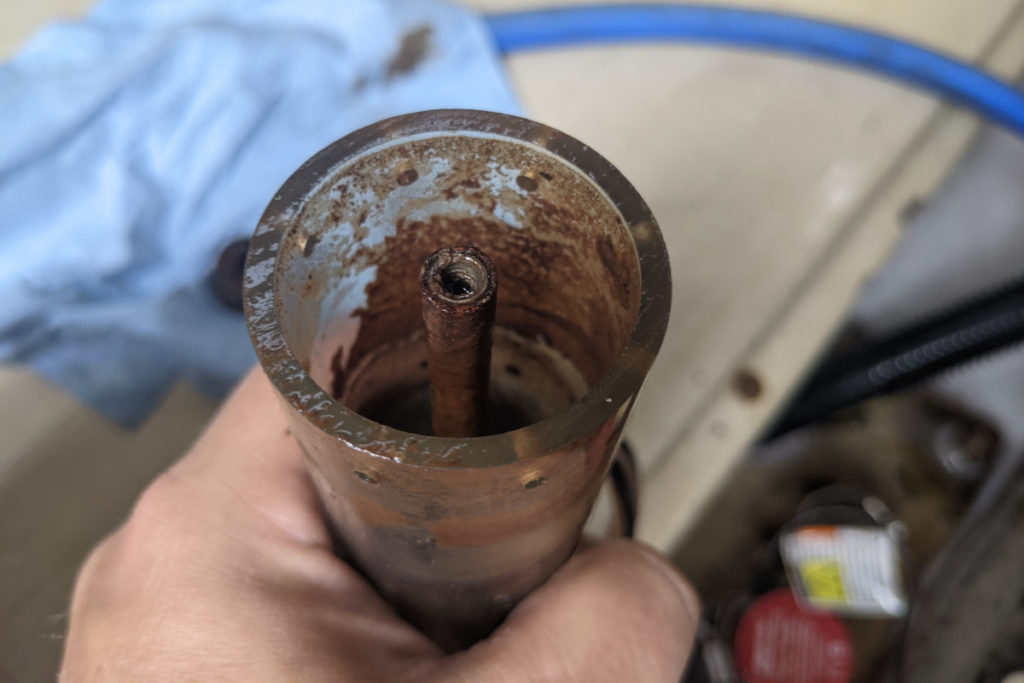
I got it all cleaned up. The only slightly annoying part was that there was some schmutz that was sticking stubbornly to the central metal rod that the float rides along. I have no idea what it even was. It reminded me of the cookie remains that are left on your hand after eating an ice cream sandwich.
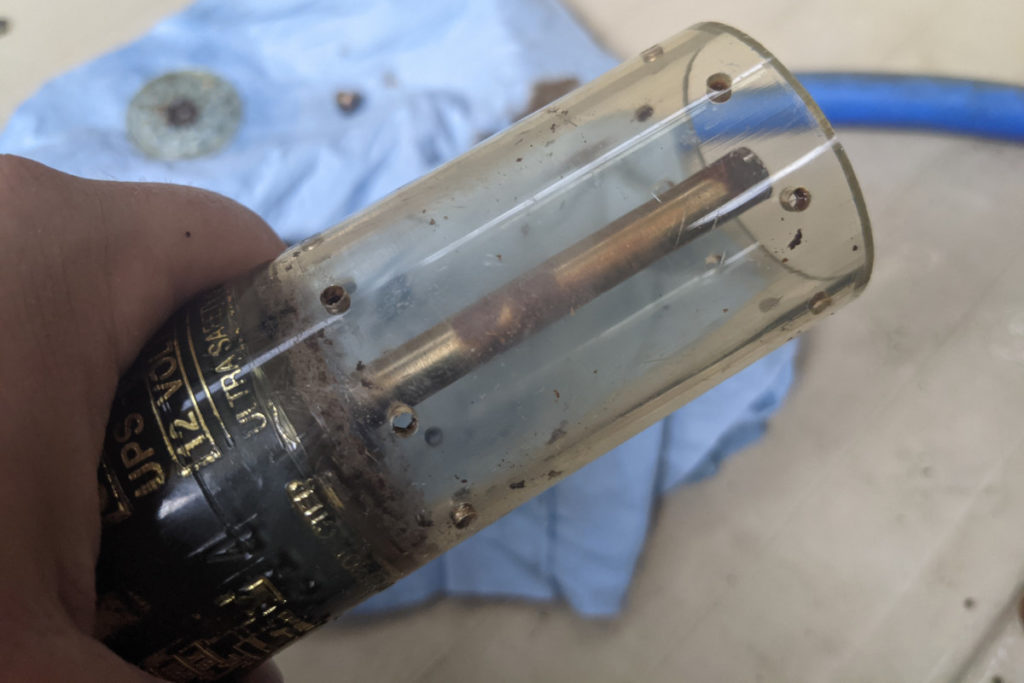
And much like the ice cream sandwich detritus, I was able to clean it off with some paper towel wrapped around a screwdriver.
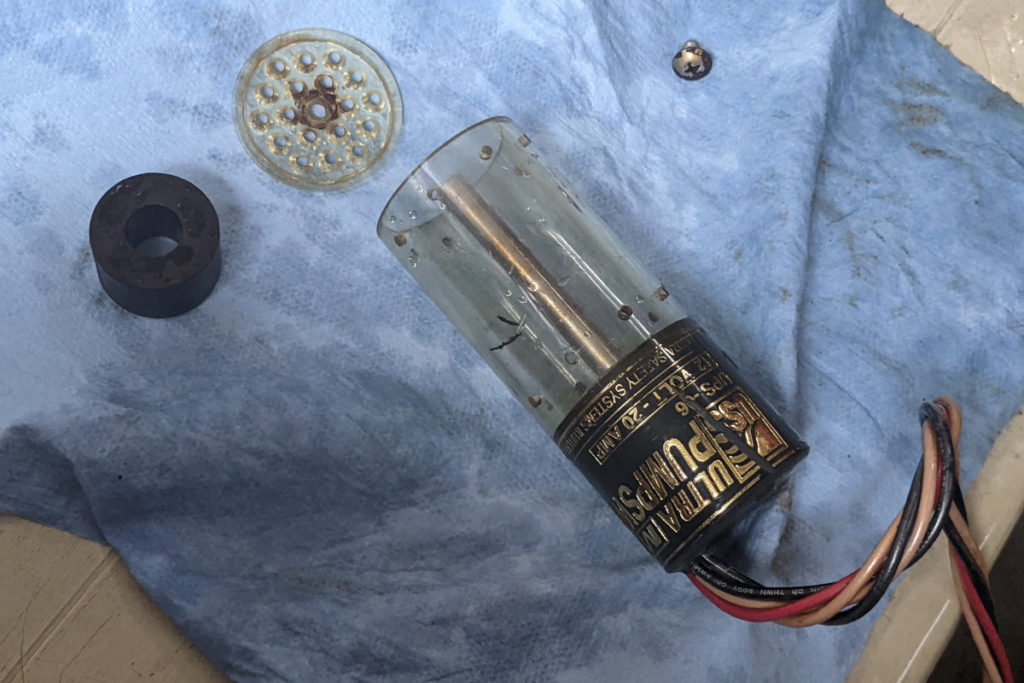
I put it all back together, now just about as clean as it had been when I first put it in, and reinstalled it. I filled the bilge with water from the hose, the pump kicked on and drained it, and then the pump continued to run, just as it had before. I took the switch out again and removed the cover so that I could manually operate the float with my finger, and found it to work correctly about one third of the time.
Then I had the annoying thought, “Wait. What am I doing?”
For all I knew, that pump may have run dry for a week straight. While it still technically worked, those are hard miles, and I no longer had any faith in it. Regardless of the switch being clean or not, I had a brand new switch, and regardless of that, I didn’t have a new pump. I had no idea why I’d performed this forensic analysis. I also didn’t think I’d be able to get a new pump—this model has a relatively high pumping power for being as physically small as it is, and it needs to be that small to fit in that bilge. I put everything back as it was (though now clean), tidied up the boat, texted Jenn to declare the trip an utter failure, and drove away.
But a couple towns over, I drove past a marine store, and perhaps more importantly, saw that they had a hot dog cart set up in their parking lot. I thought that I’d do a stroll through the store, and in the worst case, get a bite to eat. After sloshing around in a dirty bilge all morning, the idea of a dirty water dog seemed poetic. Well, hot diggity dog, they had the pump I needed.
I went back to the marina and opened up the boat again. I got out my tools, removed the old pump and switch, and installed the new ones with the alacrity of someone who had just done this whole process forty minutes ago. I unwound the hose, dragged it into the cabin, and filled the bilge to see if it would turn itself on and off automatically. It worked for about 5 seconds, made a horrible noise, and then stopped.
This was fine. There was a time when I would have been in a mild panic about this, and perhaps delved into the long string of mistakes that led me to this current mistake, which, when pondered in too much detail, can result in a sort of debilitating existential nihilism. But, you know, sometimes you have to look on the bright side of existential nihilism.
The new pump had a slightly different base than the old one, and the base is what affixes it to the bottom of the bilge. I had put one screw in loosely, so that I could swivel the base to align the holes for the second screw. I did not, however, then torque the first one down. When the pump came on, it sucked the loose screw into the impeller. I removed the entire unit and extracted the screw. The impeller didn’t look damaged, so I put it back together again. Nothing. I thought about this for a moment, and observed my surroundings.

Oh yeah; the fuse.
I went to the cockpit, where it was raining heavily and blowing 30kts, and proceeded to take all of the junk out of the port locker so that I could get to the batteries. The bilge pump is hard-wired to the batteries and doesn’t go through the normal circuit breaker panel. I found the inline fuse there, and sure enough, it was blown. I replaced that, and the pump sprang to life. I conducted several more stress tests, and everything seemed to be working normally, so once again, I packed up and left, now with a completely functional bilge pump. As always, I would like to thank hot dogs: you have been a consistent source of inspiration and nitrates in my life.
I took odd routes and didn’t pass the terrible diner in either direction on this trip, but I assume that it’s still terrible and inexplicably busy. The season is winding down, but we have through the end of the month to maybe get a couple more sails in.